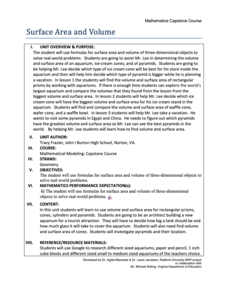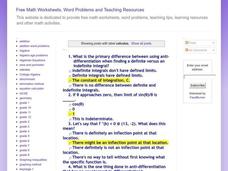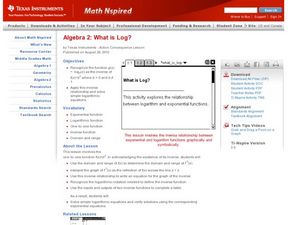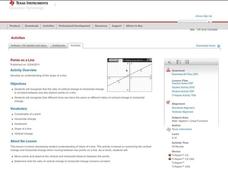Radford University
Google Earth Trip
A trip around the world sounds nice, but for now we'll just have to make do with Google Earth. Pupils use pictures of landmarks to apply geometry concepts. They determine whether each building has bilateral or rotational symmetry, search...
Radford University
Surface Area and Volume
Who knew there were pyramids in China? Learners apply surface area and volume formulas to several different real-world situations. They calculate the volume and surface area of an aquarium, an ice cream cone, and Egyptian and Chinese...
Radford University
The Ultimate Kitchen Renovation
Cook up a nice new kitchen. Future designers apply quadrilaterals to design a new kitchen floor. They create a tessellation and determine the area of the pattern. As an added component and real-world application, they must stick to a...
Curated OER
Slope Fields
Students create and analyze slope fields. In this calculus lesson, students create a visual of differential equations. They use the Ti Navigator to create slope fields.
Curated OER
Shopping for Savings
Fourth graders calculate savings and identify the best value items from a list of products. They rotate through five studying stations, completing various math activities involving calculators and solving problems related to shopping...
Curated OER
Word Problems
In this calculus instructional activity, students use integration to solve word problems they differentiate between integration and anti derivatives, and between definite and indefinite integrals. There are 3 questions with an answer key.
Curated OER
NUMB3RS Activity: Implicit Orbits
In this algebra worksheet, students solve word problems using algebraic equations and implicit differentiation. There are 16 problems dealing implicit differentiation.
Curated OER
Significant What?
Students define accuracy and precision, and differentiate between the two terms, apply the concepts of accuracy and precision to a given situation and correctly apply the concept of significant figures to measurement and mathematical...
Curated OER
Cartesian Geometry
In this geometry worksheet, students plot coordinate pairs and connect the points to create different shapes. They give th shapes its polygon's name. They differentiate between simple functions and rectangular hyperbola.
Curated OER
Modeling a Planetary Nebula
For this modeling a planetary nebula worksheet, students use a diagram to calculate the intensity at different radii from the center of the nebula. Students use the Pythagorean Theorem to determine the distance between two points on the...
Curated OER
Betweenness and the Sum of Parts
High schoolers differentiate lines and angles using betweenness in this geometry lesson. They differentiate angles and lines using Cabri Jr. and analyze the data and make conjecture.
Curated OER
A Simple Model for Atmospheric Carbon Dioxide
In this atmospheric carbon dioxide activity, students use two diagrams to solve 6 problems about atmospheric carbon dioxide. One diagram shows the Keeling Curve and the other shows sources of carbon and the natural and anthropogenic...
Curated OER
What is Log?
Young mathematicians differentiate between logs and natural logs in this algebra lesson. They solve functions and logarithmic functions. Learners also graph and rewrite the exponential and log functions.
Curated OER
Flips, Sides and Turns: Exploring Transformations
Students use an online dictionaries to define key geometric terms. They explore several websites to help them differentiate the terms reflections, translations and rotations as they apply to geometry and then complete an assessment...
Curated OER
Gateway Arc Length
Learners differentiate and calculate the length of an arc. They define an arc and relate it to the area of a circle and integrate the function to solve the equations. High schoolers use their TI calculators to graph the equation.
Curated OER
The Second Fundamental Theorem of Calculus
Students investigate the fundamental theorem of calculus. In this calculus lesson, students derive the fundamental theorem of calculus. They differentiate between the first and second theorem.
Curated OER
Dimension Review
Students differentiate the pros and cons of different areas. In this geometry lesson, students compare and contrast different sizes based on their area. They put an image to the size of a shape.
Curated OER
Weight Game
Learners estimate and compare grapefruit weights. In this weight measurement and literacy activity, students listen to the story Nate's Big Hair and the Grapefruit in There, then estimate the weight of a grapefruit after holding it....
Curated OER
Multiplying Monomials
Students differentiate between linear and quadratic functions. For this algebra lesson, students write equations of graphs and graph a function from an equation. They also identify the slope and y-intercept.
Curated OER
Introduction to Mathematical Modeling
In this mathematical modeling worksheet, students answer two essay questions. They describe Newton's Law of Cooling by describing and constructing a model and answering seven essay questions about the process.
Curated OER
Euler's Method
In this calculus activity, students answer 14 short-answer questions regarding Euler's Method, rate equations, initial conditions, and slope functions.
Curated OER
From Expressions to Equations
Learners differentiate between expression and equation by evaluating integers and observing the difference. They use the TI to see the steps to solve problems.
Curated OER
Points on a Line
How do you find slope? You use points on a line of course. slope. Teach your class how to calculate and differentiate between horizontal and vertical lines. They are sure to be pros at graphing lines on a coordinate plane by the end of...
Curated OER
Comparing Linear and Exponential Functions
Teach your class how to differentiate between linear and exponential functions. They use exponential properties to solve problems, graph them using the TI-Navigator, and make comparisons.























